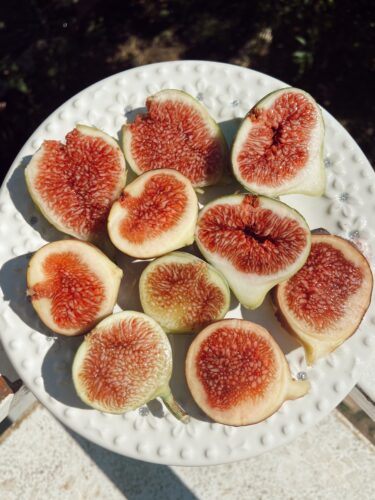
What do Mexicans eat for Christmas dinner
December 26, 2023
What is the most popular chinese foods in USA
December 30, 2023The Ultimate Guide: What is the healthiest way to eat figs?
What is the Healthiest Way to Eat Figs?
Figs are a powerhouse of nutrition, but what is the healthiest way to eat figs? The best way is to enjoy them raw and fresh — with the skin on — to get the full dose of fiber, antioxidants, and natural sweetness. You can also soak dried figs in water overnight to aid digestion and boost nutrient absorption. Whether added to salads, eaten as a snack, or blended into smoothies, figs are a naturally healthy treat your body will love!

Understanding Figs: Nature’s Unique Treat.
Although commonly labeled as fruits, figs are a distinctive type of flower known as a syconium. These tiny inverted flowers grow inside a pod, with each pod housing hundreds of flowers. The small seeds produced are the true fruit of the fig plant, enclosed in a structure called an achene, akin to what we find on strawberries. When indulging in a fig, you’re savoring multiple fruits simultaneously, with the soft, delicious part being the accessory fruit surrounding the achene.
The Roots and Stories of Figs.
Originating in Western Asia, figs journeyed to the Mediterranean through human migration, with archaeological evidence tracing their existence back to at least 5000 B.C. Some scholars posit that figs were among the first plants domesticated by humans. Throughout history, figs have symbolized peace, prosperity, and fertility, playing a vital role in ancient Greek and Roman cultures and maintaining symbolic significance in various religions.
Where and When Figs Thrive.
Figs thrive in warm, dry climates, notably in the Mediterranean region. In the U.S., California is a primary source of figs. Fresh figs are best enjoyed during the summer to early fall, and when choosing them, opt for plump ones that yield slightly to the touch. Since figs don’t ripen post-harvest, avoid very firm ones. Fresh figs are delicate, requiring refrigeration for a lifespan of about a week. Alternatively, dried, canned, and frozen figs are year-round options at grocery stores.
The Special Relationship Between Figs and Wasps.
Most figs in the U.S. grow on trees that can pollinate themselves, but some still need help from female wasps.
Here’s how it works.
Female wasps lay tiny eggs inside male figs, and when those eggs hatch, they become larvae. These mature wasps then carry fig pollen when they fly away. Now, if a female wasp goes into a female fig, she helps pollinate it, but she can’t lay eggs. Sadly, she eventually dies inside. Thankfully, the fig has a way to handle this – it produces an enzyme that completely digests the wasp. So, when you eat figs, you’re left with only seeds and no parts of the wasp.
Diverse Fig Varieties.
With hundreds of fig types varying in color and size, taste differences are subtle. All figs share a jam-like quality, evoking flavors of strawberry, currant, and date, with hints of honey, flowers, and nuts. Common U.S. varieties include Black Mission, Kadota, Brown Turkey, Calimyrna, and Adriatic figs.


Ways to Enjoy Figs.
Figs are delightful raw, or you can enhance their flavor by roasting or grilling. They prove versatile in appetizers, jams, sweet and savory dishes, and even desserts. Health-wise, figs contribute fiber, antioxidants, and essential minerals like magnesium, potassium, and calcium, supporting digestive and bone health.

Cautionary Notes about Figs.
Even though figs are usually healthy, it’s important to be mindful of a few things:
- Blood-Thinning Medications: If you’re taking medicines that thin your blood, it’s a good idea to not have too many figs. This is because figs contain vitamin K, and too much of it might interfere with your medication.
- Latex Allergy: If you’re allergic to latex, be careful with figs. Fig trees naturally make latex, and it could cause an allergic reaction in sensitive individuals.
- Enzyme Ficin: Eating too many figs might make your tongue feel uncomfortable temporarily. This is because of an enzyme called ficin found in figs. So, it’s wise to enjoy figs in moderation to avoid any discomfort.
Conclusion:
In Conclusion: A Tasty, Healthy Tradition
Figs have been cherished for centuries as both a beloved and nutritious food. Next time you encounter figs at the store, grab a couple of packs and relish in this simple, healthy treat!
How to Enjoy Figs (Even If They’re Raw!)
Ever wondered about the best way to eat figs? Those fresh figs are a treat, and you can savor them in a variety of ways, including raw with the skins and seeds. Let’s explore the delicious possibilities!
The Special Goodness of Fresh Figs
Fresh figs are a unique delight, with a soft, jammy texture and an irresistibly sweet flavor. The best part? There’s no one right way to eat them! Whether you go for raw, throw them on a grilled pizza with honey, or stuff them with nuts and cheese, the choice is yours.
When to Grab Figs
Fresh figs have a short season, so you’ll want to indulge while you can. They make a brief appearance in early summer and then come around again during the main crop from late summer to early fall. While dried figs are available year-round, nothing beats the taste of fresh ones.
A Quick Guide on How to Eat Figs
The top-notch way to relish figs is to dive into them raw, keeping the skin and seeds intact. If you prefer, you can remove the peels and scoop out the seeds or try your hand at cooking them by baking, broiling, or grilling. But if you’re in a hurry, just snap off the stem and take a big, juicy bite of the raw fig.

FAQ:
Yes, you can! The skin of figs is edible, though some folks aren’t fans of its texture. Early-season figs have delicate peels, while late-season fig skins are thicker. If you’re not keen on the peels, a vegetable peeler can come to your rescue. Otherwise, embrace the whole experience – stem and all!
Can You Eat Figs Raw?
Absolutely! Fresh figs are at their best when enjoyed raw, especially when picked straight from the tree while still warm from the sun. If that’s not an option, simply cut them in half, pair them with soft goat cheese or feta, and relish the goodness.
Can You Eat a Fig Whole?
Yes, you can! Most recipes suggest slicing them in half, but you can devour figs whole. Technically, figs are flowers, not fruits, and you can munch on the seeds too. Since the peels are fair game, feel free to pop a whole fig into your mouth after twisting it to remove the stem.
How to Select the Best Figs
When choosing figs, look for clean, unblemished skin. Skip the ones with gashes or bruises. Give them a gentle squeeze – they should be soft but be cautious not to over-squeeze. The color varies by variety – Mission figs are deep purple, Calimyrna figs are green, and Kadota figs are yellow-green.
Storing and Preparing Figs for Maximum Enjoyment
Once you bring figs home, keep them at room temperature if you plan to eat them within a day. Otherwise, store them in a plastic bag in the coldest part of the fridge for up to two days. Take them out at least 30 minutes before eating to let them return to room temperature.



